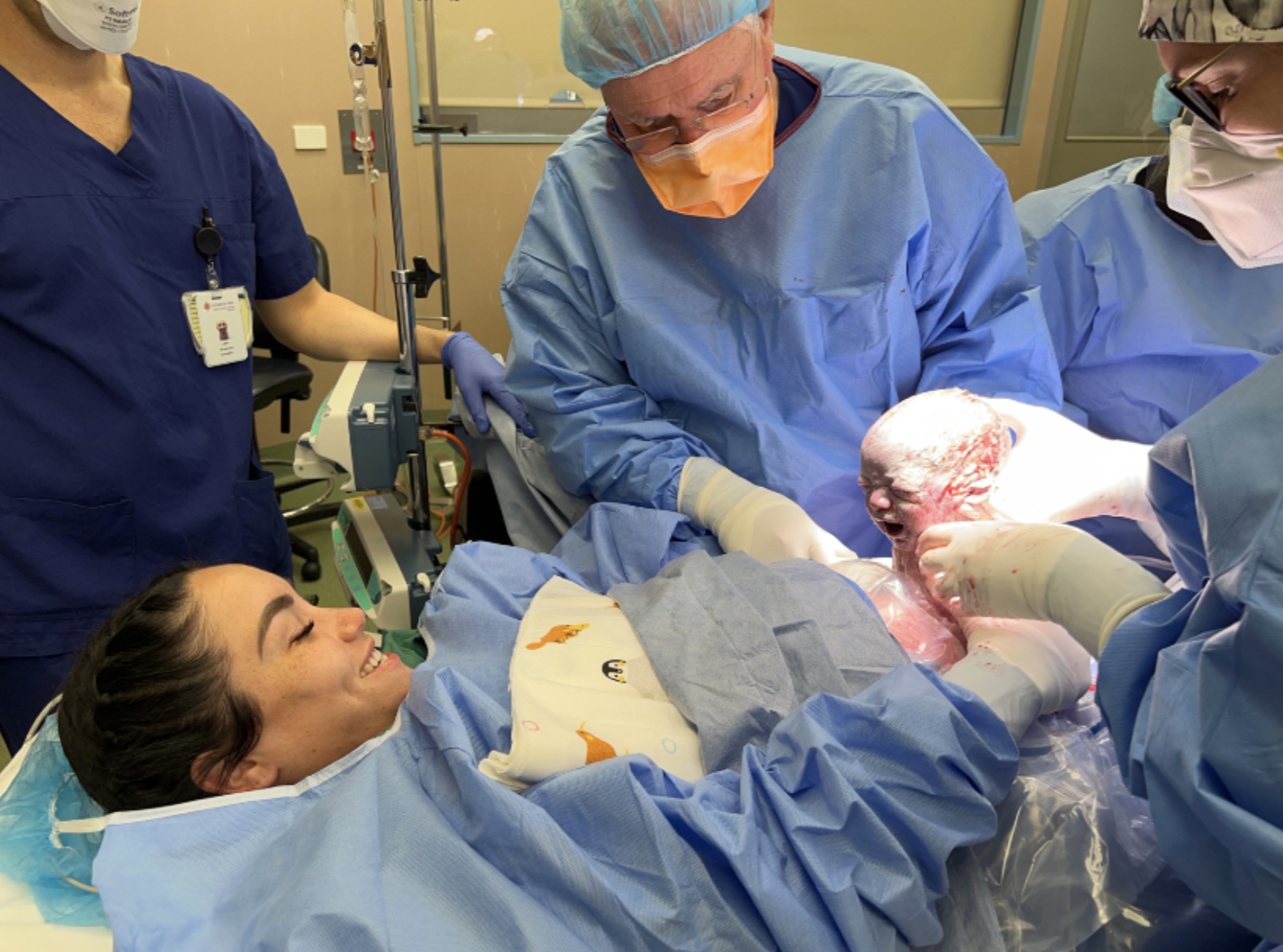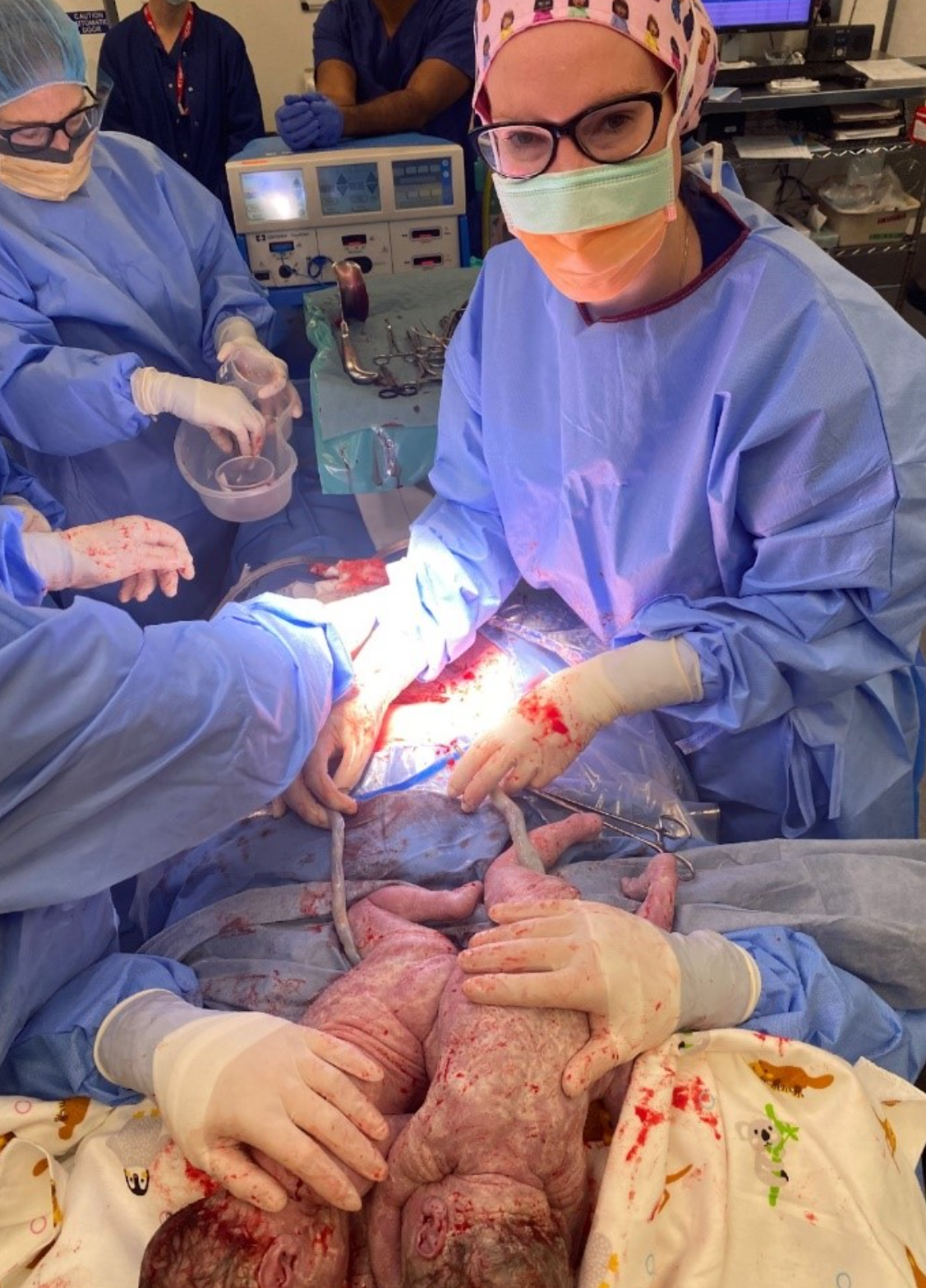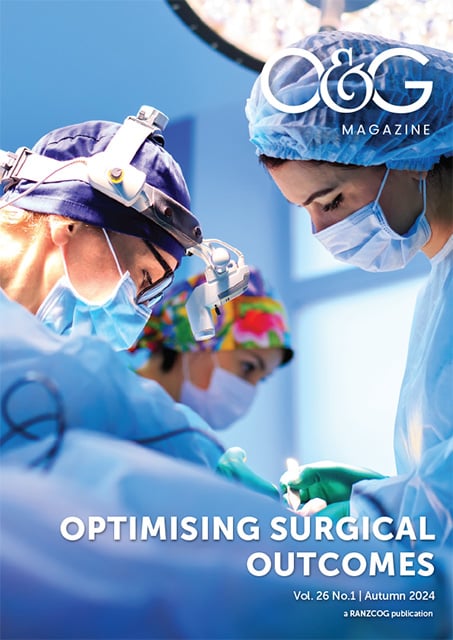Childbirth is a unique area of health care that deals with a supposed natural process but one that often needs expert assistance. In well-resourced countries the safe outcome for parents and offspring is often assumed, so the emphasis sometimes shifts to the experience of the labour and birthing process as an end in itself.
Direct involvement of the person delivering and their supporters can often be accomplished in the delivery room when a vaginal birth is taking place. However, as between 30-50% of hospital births are now by caesarean section, some parents feel disempowered. They can also feel removed from the actual experience and want to be more intimately involved. Hence the arrival of the Maternally Assisted Caesarean (MAC).
Here, we present several viewpoints related to this new development in O&G.
Dr Suzanne Meharry
Obstetrician and Sonologist, MBBS (Hons), FRANZCOG, DDU
I started performing Maternally Assisted Caesareans (MACs) in 2019 when a private patient of mine, a midwife, said: ‘I want an elective caesarean, but I want to deliver the baby myself.’ I had just started a new private practice at a local maternity hospital, and I was lucky to have a very progressive and receptive medical director. He took it upon himself to write a policy and procedure and we were ready to go.
I performed a handful early on, offering them to women I thought would benefit. But fairly quickly women started coming to me from all around the state, asking for them. Word had clearly got out, and I was finding that women who had experienced trauma with their first birth, were coming to have a MAC for their subsequent birth in the hope of it being a healing process.
For instance, there was the patient who had sustained a fourth-degree tear after a vacuum birth in a small country town. She’d been flown out RFDS to Perth for a repair and been separated from her baby for 48 hours. A priority in this birth was protection of the anal sphincter but she also wanted uninterrupted time with her baby from birth and felt that by assisting in the delivery she would maximise this.
Another patient had undergone an emergency caesarean for obstruction after a very long labour. She had a massive post-partum haemorrhage during the section with a blood transfusion, then a return to theatre for an intra-abdominal bleed. She spent the first three days apart from her baby in ICU and has very little memory of the time. She also had extreme difficulty establishing breastfeeding. Her priorities for the next birth were a safe delivery that she felt part of and immediate skin to skin.
There was also a group of women who were having a medically recommended caesarean but were keen to participate more in the birth than a traditional caesarean allows. I have now done a few in breech presentation, women with advanced maternal age and women with a previous classical caesarean.
Feedback has been amazing. Most women expressed gratitude for being able to be part of the birth. For women who had a traditional Caesar the first time they gave birth, and a MAC the second, many said the MAC felt empowering and created a wonderful memory of their child’s birth. Some women stated it was ‘the next best thing to vaginal birth’.
I have now done 73 MACs. Most of the women were extremely happy with their procedure. There were two women who said they wouldn’t do it again. One, because she didn’t feel that it was worth the effort of scrubbing and gowning, and the other didn’t feel it added much to the overall experience.
The average blood loss from the 73 cases was 480ml. There were two post-partum haemorrhages of 1000ml. Both were in women with large fibroid uteruses. There were three women treated with oral antibiotics for superficial wound infections after discharge. Two diagnosed by their GP and one by me. There were no readmissions for infections.
Patient selection is important. I usually offer a MAC to women for who a caesarean is medically indicated but who are worried they will miss out on the experience of a vaginal delivery. I have done several for babies in a breech presentation and given the whole ‘delivery’ is done by the surgeon, it certainly loses some of the experience.
Support from the whole team is important and I have had a few anaesthetists who were not keen on the procedure. The IV cannula needs to be placed high in the arm to allow access after gowning and gloving, and the patient can often obstruct the drip with a flexed arm. This often happens just as the oxytocic is given, although fortunately has not translated into an increase in blood loss.
The paediatrician needs to support the process too and I have certainly worked with a few who believe the baby should come straight to the cot post-delivery.
Over time, in my team the paediatricians have certainly become more comfortable coming over to the mother, warming and drying the baby on her chest and performing an initial examination. The midwife is also very important here, helping the mother to support her baby and bringing in warmed towels.
The biggest recurring lesson I have learned over these five years of listening to birth stories and performing maternally assisted caesareans, is that for many women the actual experience of the birth really is critically important. And saying it’s all OK as long as there is a healthy baby at the end is not enough for many women, nor their postnatal mental health and wellbeing. Women must come through their birth feeling safe, heard and respected. We are in a very privileged position to be able to help women start as mothers in this way. I am really pleased to have found the MAC to be helpful in facilitating this.

Rebecca Hamilton meets her baby after a successful MAC at St John of God Mount Lawley Hospital, Western Australia.
Photo: Supplied by Suzanne Meharry
Dr James Griffiths
MBBS, FANZCA, MEpi, PGCertCU
The Maternal Assisted Caesarean (MAC) is an increasingly popular innovation in the conduct of a caesarean delivery. The idea seems to particularly appeal to women who have had a difficult or traumatic birth experience previously, or for women who are disappointed that they have a medical indication for a caesarean birth. For many of these women, having the option of choosing to become an active participant in the delivery of their baby seems to be enormously empowering.
Anecdotally, many obstetric anaesthetists seem quite ambivalent about the relative merits of the MAC. While the actual ‘maternal assisted’ component of the delivery might only last for a few seconds, obstetricians need to be aware that the MAC represents a significant change to a ‘standard’ caesarean procedure, which needs to be planned for and communicated across the entire perioperative team.
Reliable intravenous (IV) access and continuous accurate monitoring of vital signs are key priorities for essentially every anaesthetic procedure, including the MAC.
During any caesarean delivery, the anaesthetist needs to be able to ensure timely administration of fluids and medication, including fluids, vasopressor, antibiotics, antiemetics and uterotonics. For a MAC, I generally find placing the IV cannula in the mid-forearm, preferably away from both hand and cubital fossa, where it is particularly prone to kinking and/or dislodgement. I have never found it necessary to use other sites such as veins in the upper arm (above the elbow) or the lower limb. The IV site inevitably becomes totally inaccessible as it lies within the sterile field once the mother’s arms are cleaned and she is gowned and gloved. For these reasons, the IV needs to be carefully covered with large occlusive adhesive dressings and then reliably taped prior to sterilising the patient’s arms.
Once spinal anaesthesia has been established, it is important that the anaesthetist can carefully check the adequacy of the block prior to the patient donning sterile gloves and gown. Assessing the block becomes much more difficult once the patient’s arms and torso are covered with a sterile gown.
Continuous monitoring of vital signs is important during any caesarean. In my own practice, I have seen several cases where a change in pulse oximeter reading the first sign of an evolving obstetric crisis was, including anaphylaxis and amniotic fluid embolus. During a MAC, a digital pulse oximeter obviously can’t be used on the fingers as this is within the sterile field. I have found an ear probe to be a reasonable alternative. However, in an awake moving patient, the trace is often unreliable, and the probes tend to dislodge. Placing the probe on a toe can be a reasonable alternative if the monitoring cable is long enough to reach the feet. Non-invasive blood pressure monitoring can also be unreliable, particularly while the woman is elevating her hands and arms during the sterilising process.
It shouldn’t be forgotten that the emotional wellbeing of the partner/support person is an important additional responsibility of the entire team. Many partners are anxious about being in the operating room. The set up for a MAC usually means drapes are a lot lower than for a standard CS and therefore the partner can potentially directly visualise a lot more of the surgery than they otherwise might expect. This can lead to psychological, or in the event of syncope, actual physical injury.
While the MAC is an exciting innovation, there may be alternative approaches that are simpler and easier to implement, but still give women a meaningful sense of participation in their delivery. These might include using a mirror so the patient and partner can view the birth in real time, or removing one arm from the patient’s hospital gown so the baby can be lifted directly from the surgical field onto the patient’s exposed chest. In many instances, the latter approach seems to actually provide more immediate ‘skin to skin’ contact than a MAC, where the sterile gown often gets in the way.

Suzanne Meharry (far right) with Tina Blacklock (out of the picture) and her baby twins during a MAC, which took place at St John of God Mount Lawley Hospital in Western Australia.
Photo: Supplied by Suzanne Meharry
Dr Jenny Dowd
Obstetrician, MD, FRANZCOG
After performing hundreds of Caesars and having had two myself, I think the most important issue here is the patient’s sense of control. Either control in a physical sense or control over the way a decision is made. When a caesarean is deemed to be necessary or desirable, often when not expected or following a previously disappointing delivery, some women feel disconnected from the birth and the idea of pulling their baby onto their chest makes up for this perceived loss.
The concerns raised by some paediatricians relate to immediate assessment of how the baby transitions to the extra-uterine environment. In a standard caesarean the baby is handed to a paediatrician or midwife by the surgeon onto a sterile wrap. They can then be dried and stimulated and moved in a position to assess initial breathing and circulation, often very close to the mother. In a MAC, unless the paediatrician is also surgically scrubbed, they cannot closely interact with the newborn. The natural tendency of the mother is to pull the baby up onto her chest leading to the infant facing downwards, burrowing into the drapes and so initial status may not be easily assessed. As immediate skin to skin doesn’t happen on top of a surgical gown temperature loss may also be a problem.
When discussing a MAC, the issues to consider include how comfortable the patient and birth partner are watching a surgical process, the practicalities for theatre staff and other doctors involved, and any maternal medical concerns or anticipated difficulties with delivery.
Social media speeds up the dissemination of new ideas more quickly than some institutions can adapt to, and as with any new procedure the pressure to provide a different experience needs to be balanced against safety and efficiency. The risk is to jump on the bandwagon and not prepare patients or staff well enough. My practice has already had a woman come to us asking for an elective “normal” caesarean, as she felt pressured by her previous obstetrician to have a MAC after a long first labour and finding the experience of this birth traumatic.
Informed consent involves explaining the details and alternatives and should be undertaken antenatally, with MAC done as a scheduled procedure. A full consent process should include a discussion of alternatives that may achieve what the patient wants, such as observing the delivery with a mirror (which can be quickly removed if anyone feels overwhelmed) and then having true skin to skin without surgical gloves and gowns in the way.
Eventually, however, maternally assisted caesarean will find its niche and no doubt become routine for several planned surgical births.








Leave a Reply